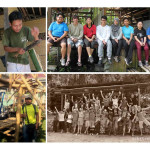Sepilok Poo Burner
Text by Billy Dunn
Photos by Billy Dunn and Ian Hall
The construction of the biogas digester at the new Sun Bear Conservation Centre in Sepilok took a bit of time to get running and underway but after ten days of hard building, pumping, lifting, grafting, sweating, itching, bleeding, plastering, twisting, bending and cutting, it was an impressive achievement thanks to the volunteers from Camps International.
After arriving in Sepilok the initial tasks facing the group were not too exciting or enjoyable but hard labour and exhausting work! We started by moving 1500 bricks from outside to inside the site, which involved a lot of timber planks, deep clay resembling a battlefield full of water and wheelbarrows with punctured wheels…not a good combination for moving bricks!
To follow, the excavated location on site for the digester was full of water. After trying to convince the girls that bailing the water out with buckets all day was the only solution, the contractors, having seen their faces, gladly lent us their pump and the water was gone soon enough.
Once the site was clean and dry, the concrete platform was revealed beneath the water and leaves. We then moved a third of the bricks down our own hand made steps, carved out from the clay, and into the centre of the circle, only to realise that the centre of the circle was actually required to draw and mark out the circular footprint for the bricks! After a brief re-location, to the girl’s delight of course, we laid out the first course. With a quick lesson in the art of bricklaying by leader Howard, we quickly learnt that bricklaying was indeed an art and not as easy as maybe expected previously!
We soon developed an effective production line of sand/cement mixing, water collecting, concrete mixing, bucket filling and distributing down the steps to the site. This was all being done in sticky wet clay, hot, humid conditions and with every builder working in Sepilok staring at our every move. Well I say “our” every move, as lovely as Matt and I are, I’m pretty sure it had something to do with all the girls working on site! The builders’ entertainment eventually turned to frustration with our bricklaying skills and they soon joined us down in the pit. A solid afternoon’s work with the contractors got us back on track and we were soon motoring on with the construction.
The arrival of the remainder of the group brought an injection of enthusiasm, plus the skills of their leaders Mann and Zul. Our initial attempts to build the dome for the digester were not as successful as we maybe first thought. Despite it being our first experience bending metal bars into circles and arcs, we were relatively happy and satisfied with our efforts. That is until Mann took one look at it and worked his magic! His construction experience was clear to see as he took our “dome” apart and began amending our “arches” into curved things of beauty! When re-attached and covered with steel mesh, the finished dome was an impressive sight.
The moment of truth came when the dome was placed onto the brick structure to find out how well it would fit. It sat perfectly and the steel circular rings were attached using the vertical metal rods bedded in between the double skin of bricks. A hard mornings work then began when the inside face of the dome was plastered, a very messy and tiring job but one that was achieved successfully in one go. To complete the group’s work, the outside face was then plastered in the afternoon and covered with damp blankets.
Without the efforts and hard grafting by the volunteers, the biofuel digester would still be a large pond on site. The group made great progress in the ten days and should be proud of the efforts! On behalf of BSBCC, I would like to thank Camps International for their contribution, as their work here will always be seen and felt by the centre for years to come.
Related posts







well done!
Just be careful because if that big hole starts to fill with water again, your newly constructed digester could float! You may need to put some water inside to hold it down.
Don’t worry, it’s already filled with water of it’s own accord. hopefully this is due to the open manholes and not indicative of the sieve-like construction.